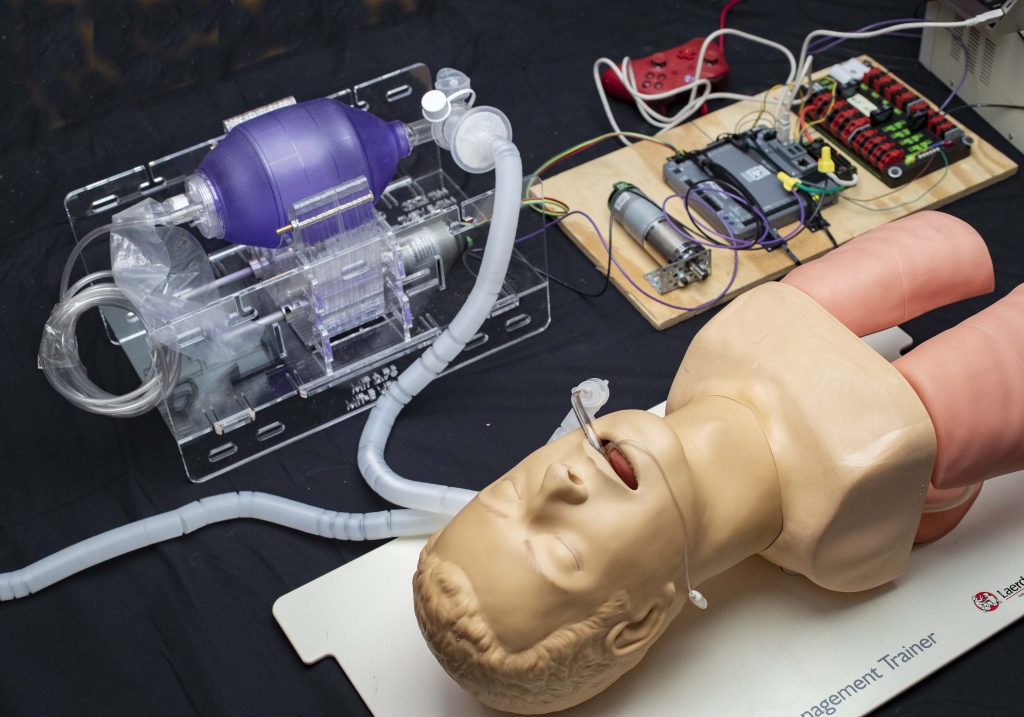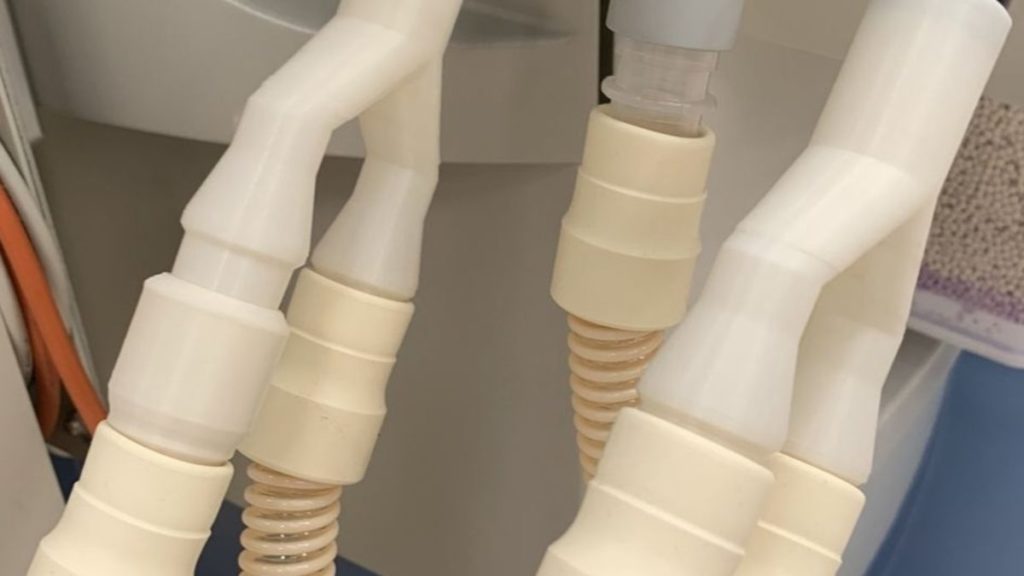Since the initial news flurry about how a network of Italian 3D printing users came to the rescue of a hospital on the front lines of the COVID-19 outbreak in Northern Italy, a number of new stories have come out about how additive manufacturing (AM) is or could be used to help medical workers. Here we will break down just some of the news that has made headlines recently.
Due to the overall inundation faced by medical workers on the frontlines of the coronavirus outbreak, the store of medical supplies doesn’t meet the demand. As most readers will know at this point, the two biggest medical items currently lacking (aside from medications and COVID-19 tests) are ventilators and masks. In part this lack of supply can be attributed to bureaucratic mismanagement, but even in locations that are well prepared for such an outbreak, there just aren’t enough masks and ventilators to go around.
While masks of varying quality can be more easily manufactured during the crisis, ventilators are complex machines that push air into the lungs via a tube placed directly into the windpipe. The computerized machines typically found in hospitals can cost up to $50,000. In turn, this sophisticated equipment features a more elaborate supply chain that has been disrupted by the outbreak. In one case, one of the biggest manufacturers of ventilators, Switzerland’s Hamilton Medical, had a request for 4,000 units in Italy, but could only ship 400.
As covered on this site regularly, AM has the benefit of flexible, on-demand and, often, local production. Evidenced by our story on the 3D printing providers in Northern Italy, it’s possible to make new spare parts at the site of medical emergencies. So far, several groups have developed emergency ventilators with 3D-printed parts that are meant to help address the COVID-19 supply crisis.
E-Vent
Former MIT student Stephen Powelson has published an open source emergency ventilator dubbed E-Vent. The system relies on automating manual resuscitation devices called Ambu-Bags that are usually located near hospital beds in order to respond to emergencies. The E-Vent consists of two motor-driven acrylic arms attached to an Arduino Uno that close in sync to compress the Ambu-Bag.
The project is up on the MIT website and includes extensive notes related to how such a system can be built. Its team members also list many clinical requirements for the assembly and use of such a device in hospital situations. Such requirements include the fact that HEPA filtration is required to prevent the spread of the virus, a doctor must be able to override the system to operate the bag manually, and the system must sound an alarm if it stops working.
VentilAid
Poland’s Ubricum has designed an open source ventilator that can be made using a 3D printer alongside off-the-shelf parts. So far, the VentilAid system is a working prototype made up of components that can be printed in PLA or ABS and TPU or other elastomeric filaments and can be printed in about 15 hours. Industrial components include a pneumatic actuator with 10-20 cm stroke, pneumatic limit switch or electric limit switch with check valve and 12VDC power supply. It has not yet been tested in a clinical setting, but can deliver compressed air reliably. A second generation version is in development that does not require compressed air or a pneumatic actuator.
Naturally, the Ubricum team describes this as a last-resort device, but ideas from this project and combined with the MIT E-Vent project could yield interesting results. Nevertheless, ventilators are complex medical devices that are manufactured in sterile environments and take into consideration a number of requirements approved by medical regulatory bodies.
Vent Splitter
Dr. Alexander Clarke, a provisional fellow in anesthesia and 3D printing enthusiast in Australia, hosts a website called ClinicFire dedicated to aggregating medical information. To respond to the COVID-19 outbreak, he developed a 3D printable tool meant to divide air from a ventilator among multiple patients.
Based off of a design invented by an emergency doctor named Charlene Babcock in Michigan, discussed in the video below, Dr. Clarke’s 3D-printable device makes it possible to enable ventilation to two or more patients. Unlike Dr. Babcock’s design, Clarke’s makes it possible to regulate air flow resistance to different patients, so that they aren’t all getting the same amount of oxygen. Printing two splitters and one flow restrictor takes about six hours on a desktop machine. A four-way splitter has been published as well, but none of his devices has been tested on people or in a lab setting. Non-3D-printed connectors have, however, been tested and safely used.
The designs are available for free on the Prusa website; however, if clinicians without printers are looking to have them printed, 3D Hubs has launched a COVID-19 Manufacturing Fund in partnership with several companies and groups around the world to produce parts on-demand through its network of manufacturing service bureaus. Grassroots organizations and nonprofits can apply to the fund to have parts printed for them.
The vent splitter seems to be one of the safest and easiest of the projects listed to actually deploy. In fact, you don’t even need to 3D print anything, if you rely on Dr. Babcock’s method, which has been used in actual clinical situations. As discussed in our previous post, 3D-printed parts suffer from porosity that can be a breeding ground for bacteria. The E-Vent project also notes the requirement of HEPA filters, which can’t be obtained by 3D printing.
Reading the notes from the E-Vent project, it is clear just how problematic effectively executing an open source respirator is in the real world, with designs not always matching up to expectations and clinical experience dictating how the E-Vent can or cannot be used. For instance, there are regular warnings such as “Caution: Actuating a manual resuscitator in free space is not representative of the forces and power needed when connected to a human’s respiratory system,” and “Caution: Much less automation is feasible due to the manual set PEEP and pop-off, which are not available in the digital control loop, as they would be in a traditional ventilator. This fundamental limitation imposed by the mechanical design of the bag limits what this system can achieve.”
When asked about the utility of 3D printed medical equipment, an emergency room doctor in this author’s family said, “I think it would be cool to be able to 3D print limited supplies, if it could be done on a large scale, but the shape, texture and porosity of the materials used are important, so we would probably only use a 3D-printed version that has been tested and proven to be equally effective and safe.”
A general practitioner in the family noted, “I think that anyone that can contribute to combating this pandemic is needed in all forms. I’ve seen reports of 3D-printed face shields that will definitely be needed. The valves would have to be tested due to the risk of contagion if one is not functioning properly.”
As we continue to cover the types of projects being initiated in an attempt the medical supply crisis associated with the COVID-19 outbreak, the opinions of medical professionals should be taken into account.
Subscribe to Our Email Newsletter
Stay up-to-date on all the latest news from the 3D printing industry and receive information and offers from third party vendors.
Print Services
Upload your 3D Models and get them printed quickly and efficiently.
You May Also Like
Reinventing Reindustrialization: Why NAVWAR Project Manager Spencer Koroly Invented a Made-in-America 3D Printer
It has become virtually impossible to regularly follow additive manufacturing (AM) industry news and not stumble across the term “defense industrial base” (DIB), a concept encompassing all the many diverse...
Inside The Barnes Global Advisors’ Vision for a Stronger AM Ecosystem
As additive manufacturing (AM) continues to revolutionize the industrial landscape, Pittsburgh-based consultancy The Barnes Global Advisors (TBGA) is helping shape what that future looks like. As the largest independent AM...
Ruggedized: How USMC Innovation Officer Matt Pine Navigates 3D Printing in the Military
Disclaimer: Matt Pine’s views are not the views of the Department of Defense nor the U.S. Marine Corps Throughout this decade thus far, the military’s adoption of additive manufacturing (AM)...
U.S. Congress Calls Out 3D Printing in Proposal for Commercial Reserve Manufacturing Network
Last week, the U.S. House of Representatives’ Appropriations Committee moved the FY 2026 defense bill forward to the House floor. Included in the legislation is a $131 million proposal for...



































